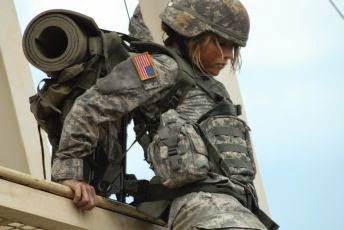The year is 2016, and two of the U.S. Navy’s latest ships are backing a key ally in the tinderbox of the South China Sea. They’re facing down the Chinese Navy halfway across the world with the latest weapons and systems the United States can get its hands on. But is it enough?
The result isn’t good. After a quick clash with China, the burning and flooded remains of naval vessels sent under-prepared into the fight is a harrowing lesson to be cautious about how we equip the U.S. military
Today, we’re sending the Littoral Combat Ship into the fray — a new class of warships developed following the 9/11 attacks.The LCS was designed to fight close to shore, a characteristic that opens the vessel up to more missions — and challenges — than most Navy ships. Versatile and agile, LCS' are lightly armed, and rely on swappable “mission modules” to increase firepower and other special capabilities such as surface warfare, minesweeping and anti-submarine warfare.A normal LCS has a rapid-fire 57-millimeter gun, a pair of 30-millimeter cannons and heavy machine guns. The ship also has Rolling Airframe anti-aircraft missiles to defend against enemy jets and incoming missiles.Compared to larger surface ships, the LCS lacks firepower — something critics of the LCS have seized upon. These critics contend the LCS should have a larger gun, longer-range self-defense missiles, and anti-ship missiles capable of taking on enemy vessels its own size.It’s 2016 and China and the Philippines both claim the shoal as part of their territory and things get uglier. Two ships of the Philippine Navy, the patrol craft BRP Emilio Jacinto and BRP Artemio Ricarde, have arrived. The potential for a shooting war is very high.Great Satan is backing up her Filipino allies: two LCSs, USS Freedom and USS Fort Worth, are both about thirty miles south of the Emilio Jacinto and Artemio Ricarde. The USS Halsey, an Arleigh Burke-class guided missile destroyer, is behind them at an equal distance.Philippine Navy have comparatively crude sensors — basically amounting to eyeballs and navigational radars — and are having a difficult time identifying all of the ship traffic in and around the shoal. There are a lot of surface contacts; some are fishing boats, and some may be… something else.An MQ-4C Triton identifies plenty of Chinese fishing boats, but also a wolf in the fold: a Chinese Jianghu-class destroyer named the Changde. Twenty miles to the west is the Qinzhou, a new Type 056 corvette.At 09:46:31, Changde opens fire on the Emilio Jacinto with its 100-millimeter deck gun. Emilio Jacinto immediately returns fire with her 76-millimeter gun and scores a lucky hit, starting a minor fire on Changde. A gunfight rages for more than three minutes, during which time Changde is struck several times.Emilio Jacinto reports she is under missile attack from the west. That would make the attacker the corvette Qinzhou. Without air defense radars and advanced weapons, Emilio Jacinto is a sitting duck. Seconds later, she is hit by several Chinese YJ-83 “Eagle Strike” anti-ship missiles, screaming in less than 30 feet above the ocean.Emilio Jacinto disappears from the command screen.Another brace of YJ-83s streaks towards BRP Artemio Ricarde. Despite the roughly 60-mile distance, Halsey attempts to intervene, launching SM-6 surface to air missiles to knock down the Chinese missiles. But the distance is too much and Artemio Ricarde is struck. The damage is catastrophic.Freedom and Fort Worth are steaming north at flank speed to engage Qinzhou and the wounded Changde, now fleeing north away from the battle zone. It’s a gamble because littoral combat ships are not well protected against anti-ship missiles, having only their 57-millimeter guns and Rolling Airframe missile launcher mounts. Qinzhou is out of anti-ship missiles. Changde might still have all of her missiles, but she’s also taken serious damage trading shots with Emilio Jacinto.Moving at more than 40 knots, Fort Worth and Freedom begin closing the gap. Qinzhou and Changde both turn to face Fort Worth. Apparently they want to fight. I’ll oblige them. Both LCSs are under orders to engage the enemy as soon as they come close enough to fire their Griffin surface to surface missiles. Between the two of them, they have 30 Griffins.At four miles, Fort Worth opens up on Qinzhou with its 57-millimeter gun. Qinzhou immediately returns fire with its 76-millimeter gun, lightly damaging Fort Worth. Unfortunately, Fort Worth’s Rolling Airframe missile launcher is destroyed early on, meaning it is out of active anti-missile defenses. Then the Griffin missile launcher is put out of action, meaning Fort Worth’s sole armament is a single 57-millimeter gun. Within moments, she too is destroyed.Fort Worth is hurt, with a bad fire and severe flooding. She's defenseless at this range. It’s time to leave. Fort Worth turns to race south at maximum speed, but it continues to be pummeled by Qinzhou’s 76-millimeter gun. Laser rangefinders, gun directing radar, 30-millimeter Bushmaster guns all knocked out…the damage reports keep coming in.Fort Worth is doomed.As if that weren’t bad enough, Halsey detects two anti-ship missiles launched to the south, halfway between it and Fort Worth and right in the vicinity of the Scarborough Shoal. Could it be a submarine? Whatever they are, they’re moving at 520 knots. The two mystery missiles streak north, towards Fort Worth. Not good. Halsey again tries to intervene, launching a salvo of four SM-6 air defense missiles that within moments are traveling at 2,400 knots. Will they reach the threats in time?
Suddenly, it no longer matters. Fort Worth capsizes.The only thing left for Freedom to do is attack. Freedom has the only anti-ship missiles within a thousand miles. Halsey has none except for a MH-60R Seahawk helicopter armed with Hellfire air-to-surface missiles, but I’m afraid of losing it to Qinzhou’s air defenses. If Freedom wants out, it has to fight its way out.
At 5.7 miles, Freedom reports there is light damage and major flooding on the already wounded Changde. She opens fire with the 57-millimeter gun, quickly scoring several hits. Changde’s gun must be damaged, because it is not opening fire. Changde takes a lot of hits but is not going down, likely because of the small size of the 57-millimeter shell. Freedom is charging ahead at more than 40 knots, blazing away with its gun.At a distance of three miles, the Griffin missiles launch. It’s about time, because the 57-millimeter gun jams. Changde already has a medium-sized fire and major flooding. Several Griffins malfunction but most score hits on Changde. Still, they don’t do any appreciable damage to the already damaged ship; Griffin missiles have a warhead that weighs as much as two laptop computers. The next largest anti-ship missile in the American inventory, Harpoon, has a warhead that weighs 488 pounds. But there aren’t any Harpoons within hundreds of miles.Finally, with the last of Freedom’s missiles expended, Changde goes down. But Quinzhou, the Type 056 corvette, has arrived at the shoal and engages Freedom with her 76-millimeter gun. Due to the short range of the 57-millimeter gun, Freedom can’t return fire. A serious dilemma: at the edge of the range envelope of the Chinese gun, do I run and get away, or do I close with the enemy and destroy him?At this point Halsey’s Hellfire-armed helicopter is at risk of being shot down, No choice except to sortee to save Freedom. It can’t sink Quinzhou, but it might inflict enough damage that would allow Freedom to get away.
Quinzhou and Freedom are now locked in a gun battle and only one is going to sail away. Freedom has a rapid firing gun and likely better fire control, but Quinzhou’s shells are larger.
Freedom catches fire. The ship begins flooding. Her gun is destroyed, pulling away, speed 41 knots, and praying Halsey’s helicopter arrives in time to cover her withdraw.
Warfare is tragic and unpredictable. Any difference in training, maintenance or secret capabilities of both navies — things we wouldn’t know until the shooting starts — could have decisively impacted the scenario.
The LCS is the Navy’s handyman, capable of doing all sorts of jobs with its mission module system. Like all handymen, it has its toolboxes to get the job done. And few handymen are really, really good at everything you might expect them to do. With all the potential missions for the Littoral Combat Ship and a limited pool of money, what do we expect it to do really well?One things for certain: the handyman’s hammer is too small
Tuesday, October 29, 2013
Battle of the South China Sea
Game on!
Subscribe to:
Post Comments (Atom)















0 comments:
Post a Comment